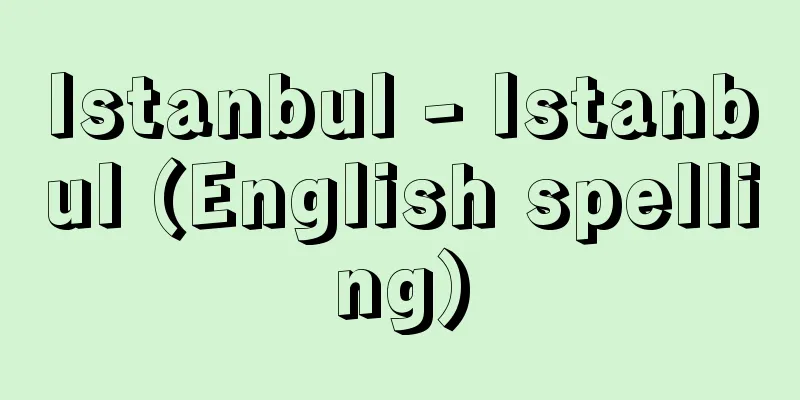Istanbul - Istanbul (English spelling)

|
Turkey's largest city, located in northwest Turkey, straddling both the east and west banks of the Bosphorus Strait, between Europe and Asia. It is also the capital of Istanbul Province. Population 8,803,468 (2000). It is the center of Turkey's culture, transportation, economy, academia, and tourism. The city area consists of the old city (divided into Eminönü, Fatih, etc.) on the European side, which inherits the history of the city known as Constantinople, the Zeytinburnu and Bakırköy districts to the west along the Sea of Marmara, and the Beöl, Beşiktaş, and Şişli districts located north of the old city across the Golden Horn, and the Uskudar and Kadıköy districts on the Asian side. Istanbul occupies an important position in Turkey's industrial production. The main industries are metals, machinery, textiles, pharmaceuticals, food, clothing, leather, paper, and electrical equipment, and traditional small and medium-sized factories are concentrated in the old city and the Sisli district. In addition, the coast of Halic Bay, which was once convenient for maritime transport, was also an excellent industrial location, but in recent years, modern factories have been moving in along the national highway to Ankara on the Asian side and to Edirne on the European side in search of convenient land transport. In addition, it has been a key maritime transportation point that controls the Bosphorus Strait since ancient times, and even today maritime traffic is thriving with the Eminönü district and Karaköy on the opposite shore as its bases, and trade activity is also active. Ferries that cross the Bosphorus Strait at several points are also an important means of transportation for the city's citizens. Meanwhile, in terms of rail transport, Sirkeci Station, famous as the terminal station of the Orient Express, is located in the Eminönü district, and Haydarpaşa Station, which connects to Ankara and other areas, is located on the Asian side. In addition, the 1,074-meter-long Bosphorus Bridge was built in 1973, and since the opening of European Highway No. 5, interchanges have been established in several places within the city, making it convenient for road transport as well. The city's air gateway, Yesilköy International Airport, is located 22 kilometers west of the city. Istanbul, with its long history, is filled with historical sites and historic buildings. In particular, the old town is home to Topkapi Palace (current museum), Hagia Sophia (current museum), Sultan Ahmet Mosque (Blue Mosque), Suleymaniye Mosque, and the Valens Aqueduct, and parts of the Byzantine wall that bounded the west of the old town remain. The old town was registered as a World Heritage Site in 1985 (World Cultural Heritage). In addition, the new town to the north, connected by Galata Bridge over Halic Bay and Ataturk Bridge, is home to the Galata Tower, which retains traces of the Genoese settlement, and Dolmabahçe Palace, famous as the place where Ataturk died while in office. The Grand Bazaar, a traditional commercial district in the old city, is famous for its grand scale, but the new city to the north of Halic Bay also has bustling commercial districts such as Taksim Square and Istiklal Street. The old city is home to academic and cultural facilities such as the Archaeological Museum, the Ancient Orient Museum, the Museum of Islamic Art, and Istanbul University. [End line] historyIts origins date back to a settlement of Thracians who migrated from the Balkans, but it was colonized by Greeks in the mid-7th century BC and called Byzantium, where it flourished as a base for fishing and maritime trade. It became an allied city of Rome in 201 BC, but Emperor Septimius Severus occupied it between 193 and 196 AD, building a city wall, a hippodrome, baths, and other facilities. In 330, Emperor Constantine the Great made it the capital of the eastern part of the Roman Empire, and the city was subsequently called "Constantine's City," or Konstantinopolis (Constantinople), and by the 4th century it had become a large city with a population of 200,000. In 413, Emperor Theodosius expanded the city walls, which remain to this day. The main buildings were built on seven hills in imitation of Rome. The town was divided into 14 districts and had over 400 churches and chapels. Among them, the Hagia Sophia (Aya Sophia), built in 326, was the center of the Eastern Christian world. After the division of the Roman Empire into Eastern and Western Rome in 395, it prospered as the capital of the Eastern Roman (Byzantine) Empire, reaching a population of 500,000 in the early 5th century and then reaching a million at one time. When the Venetians and Genoese entered the Mediterranean trade around the 11th century, they controlled the commerce and finances of the Byzantine Empire, and the town's prosperity was lost. When it was occupied by the Fourth Crusade in 1204, the town was plundered, and the Byzantine Empire moved its capital to Nicaea. After the collapse of the Latin Empire by the Crusades in 1261, it was restored as the capital of the Byzantine Empire, but the town had already lost all traces of its former self, and by the time it was conquered by the Ottoman Empire in 1453, its population was only 30,000 to 50,000. Immediately after his conquest, Mehmed II of the Ottoman Empire (reigned 1451-1481) converted many churches, including the Hagia Sophia, into mosques, and in 1457 made the city the capital of his empire, changing its name to Istanbul. He forced Turks, Greeks, Armenians, and others to move to the city from Anatolia and the Balkans, and established social facilities such as mosques, bazaars, caravanserai, schools, and hospitals. At the end of the 15th century, a large number of Spanish Jews were accepted into the city, and merchants, craftsmen, scholars, and writers were also migrated to the city from Samarkand in Central Asia and various parts of Western Asia. As a result, it was revived in history as a large city with a population of about 500,000 by the mid-16th century. During the height of the empire's power under Suleiman the Magnificent (reigned 1520-1566), the city flourished as the home base of the Ottoman fleet, which controlled the Black Sea and Mediterranean Sea, and as a center of international trade stretching from East to West and North to South. When the population reached 700,000 at the end of the 16th century, the city was plagued by food shortages and inflation, and rebellions by the standing army and popular uprisings occurred frequently. Since the Byzantine Empire, the Galata district on the right bank of Halic Bay had been a settlement for Italian merchants, but from the 17th century onwards, European countries such as Britain and France competed to build consulates here, and Christian churches were also built, forming a new town. In 1845, the Galata Bridge was built across Halic Bay, connecting the old and new towns. Throughout history, the city has suffered frequent disasters, including fires, earthquakes, and tsunamis. In January 1774, a major fire burned down 20,000 houses, and in January 1839, the Ottoman government office (Bab Ali) was completely burned down. After the 19th century, as the empire modernized and colonized, the city became the center of the anti-imperialist movement of the peoples of West Asia and the Balkans, while public facilities such as schools, libraries, electricity, city gas, and water were built by European capital and the Ottoman court. After World War I, when anti-imperialist movements by Turks arose in Anatolia, the Allied powers, including the United Kingdom, officially occupied the city in March 1920. When the Republic of Turkey was established in 1923 and the Ottoman Empire collapsed, the capital was moved to Ankara. [Yuzo Nagata] "Istanbul Guide by Toshiro Natani (Heibonsha Color Paperback)" Source: Shogakukan Encyclopedia Nipponica About Encyclopedia Nipponica Information | Legend |
|
トルコ北西部、ボスポラス海峡の東西両岸、ヨーロッパとアジアにまたがって所在するトルコ最大の都市。イスタンブール県の県都でもある。人口880万3468(2000)。トルコの文化、交通、経済、学術、観光の中心である。市域は、ヨーロッパ側は、コンスタンティノープルとよばれていた昔を受け継ぐ旧市街(エミニョニュ、ファティフ地区などに分かれる)のほか、その西方、マルマラ海沿いに延びるゼイティンブルヌ、バクルキョイ地区、およびハリチ湾(金角(きんかく)湾)を隔てて旧市街の北に位置するベイオゥル、ベシクタシュ、シシュリ地区などからなり、またアジア側は、ウシュキュダル、カドゥキョイ地区などからなる。 イスタンブールはトルコの工業生産のうえで重要な地位を占める。おもな業種は金属、機械、繊維、薬品、食料品、衣料、皮革、製紙、電気機器などであり、伝統的な中小工場が旧市街やシシュリ地区などに凝集する。そのほか、かつては海運の便のあるハリチ湾沿岸も優れた工業立地点であったが、近年は陸運の便を求めて、アジア側ではアンカラへ通じる国道、ヨーロッパ側ではエディルネへ通じる国道沿いに、近代工場の進出がみられる。また、古来ボスポラス海峡を扼(やく)する海上交通の要衝で、現在もエミニョニュ地区やその対岸のカラキョイなどを拠点にして海上交通が盛んであり、貿易活動も活発である。また、ボスポラス海峡を数か所で横断するフェリーの便は、市民の重要な足となっている。一方鉄道交通の面では、エミニョニュ地区にオリエント急行のターミナル駅として著名なシルケジ駅があり、アジア側にはアンカラなどに通じるハイダルパシャ駅がある。また、1973年に延長1074メートルのボスポラス橋が架せられ、ヨーロッパ・ハイウェー5号線が開通してのちは、市域の数か所に設けられたインターチェンジによって、自動車交通の便も好条件にある。なお、空の玄関口イェシルキョイ国際空港は市街地の西22キロメートルにある。 長い歴史を背負ったイスタンブールには史跡や由緒ある建造物が満ちあふれている。とりわけ旧市街には、トプカプ宮殿(現博物館)、ハギア・ソフィア(現博物館)、スルタン・アフメット・モスク(青のモスク)、スレイマニエ・モスク、ウァレンスの水道橋などがあり、旧市街の西を限っていたビザンティン時代の城壁もその一部が残されている。旧市街は1985年に世界遺産の文化遺産として登録されている(世界文化遺産)。また、ハリチ湾に架せられたガラタ橋、アタチュルク橋によって通じる北の新市街にも、ジェノバ人居留地の名残(なごり)をとどめるガラタ塔、アタチュルクが執務中死去した場所としても著名なドルマバフチェ宮殿などがある。旧市街にある伝統的商業区グランドバザールは規模の壮大さで有名であるが、ハリチ湾の北の新市街にもタクシム広場やイスティクラール通りなど活況を呈した商業区がある。旧市街には、考古学博物館、古代オリエント博物館、イスラム美術博物館、イスタンブール大学などの学術・文化施設がある。 [末尾至行] 歴史起源は、バルカン半島から移住したトラキア人の集落に求められるが、紀元前7世紀中ごろギリシア人によって植民され、ビザンティウムByzantiumとよばれて漁業や海上貿易の基地として栄えた。前201年にローマの同盟都市となったが、紀元後193~196年にセプティミウス・セウェルス帝はここを占領し、城壁、競馬場、浴場などを建設した。330年よりコンスタンティヌス大帝はここをローマ帝国東方領の首都とし、以後この町は「コンスタンティヌスの町」すなわちコンスタンティノポリスKonstantinopolis(コンスタンティノープルConstantinople)とよばれ、4世紀には人口20万に上る大都市となった。413年テオドシウス帝によって城壁が拡大され、それが今日に残されている。主要な建築物はローマを模して七つの丘に建てられた。町は14の地区に分けられ、400を超える教会、礼拝堂があった。なかでも326年に建立されたハギア・ソフィア(アヤ・ソフィア)大聖堂は東方キリスト教世界の中心をなしていた。395年における東西ローマの分裂後は東ローマ(ビザンティン)帝国の首都として繁栄し、5世紀初めには人口50万に達し、その後100万を数えた時期もあった。11世紀ごろからベネチア人やジェノバ人が地中海貿易に進出すると、ビザンティン帝国の商業と財政は彼らに支配され、この町の隆盛は失われた。1204年第四次十字軍によって占領されると、町は略奪され、カイ帝国は首都をニカイアに移した。1261年十字軍によるラテン帝国が崩壊してビザンティン帝国の首都として復帰したが、町はもはや昔日のおもかげを完全に失い、1453年にオスマン帝国によって征服されたころには人口は3万ないし5万にすぎなかった。 オスマン帝国のメフメト2世(在位1451~1481)は、征服後ただちにハギア・ソフィア大聖堂をはじめ多くの教会をモスクに変えるとともに、1457年以降この町を帝国の首都としてその名をイスタンブールと改めた。彼はアナトリアとバルカン各地から、トルコ人、ギリシア人、アルメニア人などをこの町に強制移住させ、モスク、バザール(市場)、キャラバン・サライ(隊商宿)、学校、病院などの社会施設を整えた。15世紀末にはスペイン系のユダヤ人が多数受け入れられたほか、中央アジアのサマルカンドや西アジア各地から商人、職人、学者、文人の移住が相次いだ。その結果、16世紀中ごろには人口50万ほどに達する大都市として歴史上に復活した。スレイマン1世(在位1520~1566)の帝国最盛期には、黒海、地中海の制海権を掌握したオスマン艦隊の本拠地として、また、東西、南北に及ぶ国際貿易の中心として栄華を極めた。16世紀末に人口70万に達すると、食料難、インフレにみまわれ、常備軍団の反乱や民衆蜂起(ほうき)が頻発した。ビザンティン帝国時代よりハリチ湾右岸のガラタ地区はイタリア人商人の居留地であったが、17世紀以後イギリス、フランスなどのヨーロッパ諸国が競ってここに領事館を建設し、キリスト教諸教会も建立されて新市街を形成した。1845年に旧市街と新市街とを結ぶガラタ橋がハリチ湾に架けられた。 歴史時代を通じてこの町はたびたび火事、地震、津波などの災害にみまわれた。1774年1月の大火では2万戸が焼失したといわれ、1839年1月にはオスマン帝国の政庁(バーブ・アーリー)が全焼した。19世紀以後、帝国の近代化と植民地化とが進むと、一方ではこの町は西アジア、バルカン諸民族の反帝国主義運動の中心地となったが、他方ではヨーロッパ資本やオスマン宮廷の手によって各種学校、図書館、電気、都市ガス、水道などの公共施設が建設された。第一次世界大戦後、トルコ人による反帝国主義運動がアナトリアに起こると、イギリスをはじめとする連合国は1920年3月にこの町を正式に占領した。1923年トルコ共和国が成立してオスマン帝国が滅亡すると、首都はアンカラに移された。 [永田雄三] 『那谷敏郎著『イスタンブール案内』(平凡社カラー新書)』 出典 小学館 日本大百科全書(ニッポニカ)日本大百科全書(ニッポニカ)について 情報 | 凡例 |
Recommend
Tone (English spelling)
Fluctuations in pitch within a syllable. Also call...
Ball - Gyoku
〘noun〙① A type of jewel. A general term for hard j...
Gyrodactyliosis - Gyrodactyliosis
...growth is stunted and food value is seriously ...
Zhao Kuang - Chokyo
Dates of birth and death unknown. A scholar of th...
Tombs of Yang Gao Han
A group of Han dynasty tombs located in Guchengbao...
Okariya - Okariya
…On the other hand, Ochaya started out as tea hou...
Barbaros Hayreddin Paşa
1483?-1546 A 16th-century admiral in the Ottoman N...
Gengou, O. (English spelling) GengouO
…Once infected, it is said that one is immune to ...
Kanno Disturbance
The term refers to the division of the central br...
Welsh corgi [breed] (English spelling)
A domestic dog that originated in England. There a...
"Esprit Nouveau" - Esprit Nouveau
…He started out as a Cubist, but was not satisfie...
Reverse Tiger's Mouth - Gyaku no Koguchi
…Because the bow is drawn forward to the left, tu...
Bernard (of Clervaux)
1090‐1153 French Christian thinker and saint. His ...
Shimozawa Kan - Shimozawa Kan
Novelist. Born on February 1, 1892, in Atsuta Vil...
Lake Kitagata
A long, narrow lake formed in a dissected valley ...









